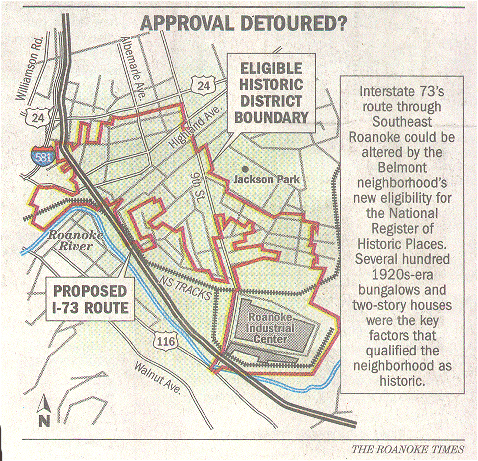|
I-73 Final Environmental Impact Statement Delayed Nov. 14, 2002: Virginians For Appropriate Roads (VAR), a BREDL chapter, has won a battle in the nearly decade-long fight against a new terrain interstate from Roanoke, VA to the North Carolina state line. VAR efforts and consultation work with Harry Reem, a historic preservation consultant from Arlington, VA, has led to a portion of Southeast Roanoke to be included as eligible for historic designation. The approved I-73 route would traverse this section. The working class neighborhood's 1920s-era bungalows and two-story houses, known as Four Squares, qualify for the National Register of Historic Places, the Interior Department said. The new historic status, granted in a memo signed by the Keeper of the National Historic Register on Oct. 18, means Virginia Dept. of Transportation (VDOT) and Federal Highway Administration (FHWA) officials must re-evaluate the route through Southeast Roanoke. Reem's complete analysis convinced the keeper of the National Register. The "late 19th- and early 20th-century, mixed-use, blue-collar working class neighborhood is historically and architecturally significant for its association with the history of Roanoke's growth as a booming industrial center and railroad hub," said the comments from Patrick Andrews, the register keeper. "The district contains locally important factories and hundreds of vernacular bungalows and American Foursquare residences of industrial workers," the memo said. Ed Sundra, FHWA in Richmond, told the Roanoke Times that the agencies will do "whatever it takes to avoid the resource. I won't rule anything out." The final environmental impact statement for I-73 already has taken more time than expected. Two endangered species have delayed the release. The Roanoke logperch and the James spinymussel are found in the path of I-73. The FHWA and VDOT are awaiting to see if the U.S. Fish and Wildlife Service will further review the logperch and mussel. VAR has also consulted with experts about the impacts to the Roanoke logperch. VAR is also seeking eligibility for another historic community along the I-73 path. Andrea Ferster, a public affairs lawyer in Washington, D.C., is assisting VAR. Meanwhile, some local politicians have been voicing their opposition to the route selected by the Commonwealth Transportation Board in May 2001. Roanoke City Councilman Bill Bestpitch and Roanoke County Supervisor Joe McNamara have publicly voiced opposition. According to the Roanoke Times, at McNamara's urging, Board Chairman Butch Church sent a letter to state Secretary of Transportation Whitt Clement asking for "a proposed timeline" for I-73. If VDOT doesn't give a satisfactory answer, McNamara said, "I think we should go on record opposing the project." Virginia financial woes have scaled back many transportation projects. I-73 is still in the Six-Year Transportation Development Plan, but there is no money allocated for its construction.
Note: The section displayed in the map which is on the other side of the Roanoke River (Southwest portion) was declared eligible for historic designation a couple of years ago. Efforts by another citizens group, Riverland Alert Neighbors, led to this earlier designation. Some information taken from articles from The Roanoke Times.
|
